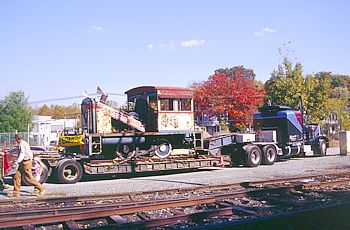
In 1993, the Delaware Otsego System, parent company of the NYS&W, donated the old Whitcomb locomotive to the United Railroad Historical Society of NJ (URHS), which is holding and restoring certain pieces of railroad equipment that will be housed in the future New Jersey Railroad & Transportation Heritage Center.
In 1994, the Susquehanna demolished the Green Pond Enginehouse and the Whitcomb was towed to the NYS&W’s yard at Butler, NJ for storage.
The Whippany Railway Museum conveyed to URHS its desire to lease and display the Whitcomb at its site where it would be cosmetically restored to the NYS&W maroon and gray scheme and numbered ‘151’. Years would pass before the engine would make its way out of Butler and head on down to Whippany.


2001 presented itself as the year when everything finally fell into place and the Whitcomb could make its move. The Whippany Railway Museum worked with URHS and the members of the Military Transport Association of North Jersey (MTANJ), a group of dedicated military vehicle historians who acquire, refurbish and operate their privately-owned former U.S. Army trucks, Jeeps and tanks for historic purposes. The MTANJ contacted the NYS&W and arrangements were made with the railroad to come onto NYS&W property and safely load and remove the locomotive.



A member of the Military Group volunteered his tractor and heavy-duty “low-boy” trailer, as well as his expertise. The individual members volunteered the use of their historic trucks to pull the locomotive up a specially-built ramp by using their front-end power winches.
At about 8:30 AM, on the morning of October 20, 2001, Museum personnel arrived at Butler Yard and met up with about 10 MTANJ members. Work began shortly thereafter. The Morristown & Erie Railway (M&E) had loaned four sections of rail that would be formed into a ramp so that the Whitcomb would be able to climb onto the trailer. The Susquehanna donated the temporary use of several crossties, spikes and track bolts. With everyone from both groups working together, the ramp was constructed in less than two hours. The locomotive was then safely hauled up onto the low-boy by the powerful winches and cables of the military trucks. By Noon, the locomotive was tied down and ready for its trip over the highways to its next temporary storage site on the M&E.

After a well-deserved lunch break, a quick run down Route 287 to Route 10 brought many stares to the unusual “convoy.” The locomotive caused quite a nuumber of second looks, but it seemed that the group of old military trucks, traveling ahead and just behind the Whitcomb, caused many travelers to wonder just what the “Army” might be up to with all this vintage equipment.